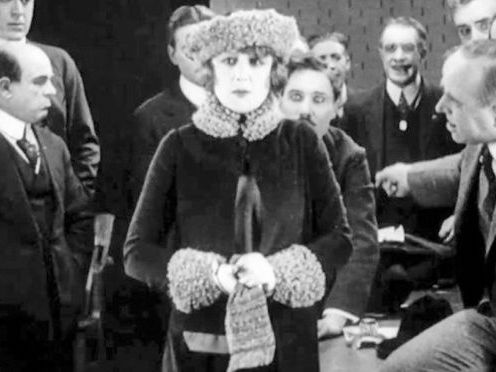THE WOMAN UNDER OATH
John M. Stahl (US 1919)
Stahl’s most famous film is surely 1944’s Technicolor film noir Leave Her to Heaven, which stars Gene Tierney as a woman who causes emotional devastation in the life of her novelist husband (Cornel Wilde), and culminates in a dramatic trial scene. His The Woman Under Oath (1919), made 25 years previously, also pivots on a trial, a novelist, flashbacks, and a mystery.
This film, from relatively early in Stahl’s career, is a courtroom melodrama. A young working-class man called Jim (Gareth Hughes) is accused of murder and subjected to a terrifying “third-degree” interrogation by the cops, and when his case comes to trial a novelist called Grace (Florence Reed) is selected for jury duty. In the world of the film, she’s the first woman in the state to sit on a criminal jury, although in fact New York wouldn’t allow such a thing until 1927. There are two stories going on here – Grace’s and Jim’s – and although the film keeps us guessing, the connection between them is not made clear until the very end.
Reed and Hughes both give strong leading performances. Reed’s career began on the stage, but she appeared in movies from 1915 until the late 1930s, including making three films with Stahl, before finishing her career on TV in the 1950s. She is best remembered now for playing Miss Havisham in Universal’s 1934 Great Expectations. Gareth Hughes, who gives a particularly haunting portrayal of a wronged man, is an especially intriguing character in Hollywood history – a Welshman who specialized in sensitive young heroes such as Jim, both on Broadway and in silent movies. His breakthrough movie role came a couple of years after The Woman Under Oath, when he starred in the film adaptation of J. M. Barrie’s Sentimental Tommy. His co-star in that film, which is now lost, was May McAvoy, who also appears here. New Yorker McAvoy, who will be familiar from the 1925 adaptation of Ben-Hur, Ernst Lubitsch’s Lady Windermere’s Fan, or The Jazz Singer, plays Grace’s sister Edith. Mildred Cheshire is especially memorable as Jim’s unfortunate girlfriend Helen, a victim of workplace sexual harassment, and another British actor plays the villain: Scottish stage veteran David Powell appears as the late, and very much unlamented, Edward.
In 1931, the Los Angeles Times asserted that “Perhaps the most significant factor in John M. Stahl’s success … is his accurate understanding of the ‘the women’s viewpoint’,” and this film provides ample evidence for that. The Woman Under Oath was made when American women still didn’t have the vote, and yet it chooses to tackle a rather progressive proposition: “Is a woman temperamentally fitted for service on a jury in a criminal case?” The subject matter was considered so hot at the time that titbits such as this were dropped into Motion Picture News while the film was in post-production: “Because, it is said, of the nature of its title, early publication of which might lead to imitation owing to the timeliness and importance of its subject, no main title has yet been announced, but it is promised that the piece deals with a topic of new and vital public interest hitherto unutilized either on stage or screen.”
In the end, Stahl’s The Woman Under Oath puts the case for women having their specific knowledge, as well as sympathy, to bring to bear on a trial. The murder case cannot be solved entirely by men, their assumptions or their brute force. Not only that, but the film shows Grace debating the case late at night, in a locked room with her 11 fellow male jurors. That’s exactly the kind of compromising position that some feared women would be placed in if they were allowed to serve on criminal juries. Grace keeps a cool head, though, even when her peers attempt to browbeat her into agreement, a moment that Stahl chooses to stage so that it echoes Jim’s own coercion earlier in the film. The Woman Under Oath, like many of Stahl’s silent melodramas, has a satisfyingly knotty plot, with a twist in the tail, which he used once more in an early talkie he produced at Tiffany-Stahl in 1929, Painted Faces.
Pamela Hutchinson


regia/dir: John M. Stahl.
photog: John K. Holbrook.
cast: Florence Reed (Grace Norton), Hugh Thompson (John Schuyler), Gareth Hughes (Jim O’Neil), David Powell (Edward Knox), Florida Kingsley (Mrs. O’Neil), Mildred Cheshire (Helen), May MacAvoy [McAvoy] (Edith Norton), Harold Entwhistle (giudice/The Judge), Thomas McGuire (procuratore/District Attorney), Walter McEwen (avvocato difensore/Defense Attorney), Edward Brennan (cancelliere/Clerk of the Court), Frank De Camp (capo della giuria/Foreman of the Jury), Edward Elkus (giurato/A Juryman).
prod: A. J. Bimberg, Tribune Productions, Inc.
dist: United Picture Theatres of America, Inc.
uscita/rel: 29.06.1919.
copia/copy: 35mm, 5555 ft., 73′ (20 fps); did./titles: ENG.
fonte/source: BFI National Archive, London.




